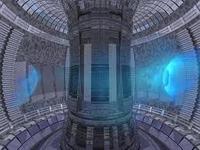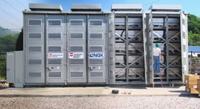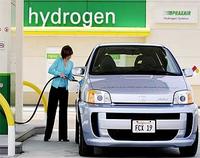-
One step closer to controlling nuclear fusion
Nuclear fusion – heating gas to several million degrees so it becomes plasma — holds the promise of abundant energy, but controlling the fusion process inside a nuclear reactor is exceedingly difficult; scientists achieve a breakthrough in controlling instability in the plasma
-
-
New material for building thermonuclear fusion reactors

Two European projects – ITER and DEMO — propose development of fusion reactors that are economically viable; this work depends on the development of new structural materials capable of withstanding damage by irradiation and elevated temperatures resulting from the fusion reaction
-
-
Depleted gas reservoirs used for carbon storage

One way to keep CO2 from accumulating in the atmosphere is to bury (or “sequester”) it under ground; a demonstration project in Australia verified that depleted natural gas reservoirs can be used for geologic carbon sequestration; the carbon sequestration approach involves pumping CO2 deep underground for permanent storages
-
-
Cleaning toxins from the oilsands
Oilsands development uses a vast amount of water and even though it’s recycled multiple times, the recycling concentrates the toxins and metals leftover from extracting and upgrading the bitumen, resulting in controversial tailings ponds that are a significant risk to the environment; scientists offer a way to make oilsands exploitation cleaner
-
-
Scrub carbon dioxide directly from the atmosphere too expensive
While it is possible chemically to scrub carbon dioxide from Earth’s atmosphere in order to lessen the severity of global warming, the process is prohibitively expensive for now; best to focus on controls for coal-burning power plants, say researchers
-
-
Small, modular reactors to figure in U.S. energy future
A newly released study concludes that small modular reactors (SMR) may hold the key to the future of U.S. nuclear power generation; an SMR would have a generating capacity of 600 megawatts or less, would be factory-built as modular components, and then shipped to their desired location for assembly
-
-
Shale gas development and healthy water sources
Geological formation known as the Marcellus Shale contains gas reservoir holding nearly 500 trillion cubic feet of technically recoverable gas; at current use rates, that volume could meet the U.S. demand for natural gas for more than twenty years; trouble is, extracting shale gas involves considerable pollution risks for water; Pennsylvania has more miles of stream per unit land area than any other state in the United States – and it is concerned about the quality of its water if more shale gas is extracted
-
-
Large-scale power storage for the energy grid

The sun does not always shine and the wind does not always blow; Stanford University researchers have used nanoparticles of a copper compound to develop a high-power battery electrode that is inexpensive to make, efficient and durable that it could be used to build batteries big enough for economical large-scale energy storage on the electrical grid
-
-
Serving and protecting – and saving money in the process

As municipalities battle tight budgets and rising gasoline prices, law enforcement fleets across in the United States have found a way to save taxpayer dollars by shifting to clean-burning, American-made propane autogas
-
-
New source of energy: urine
Urine is the most abundant waste on Earth; American chemists have combined refueling one’s car and relieving one’s bladder by creating a new catalyst that can extract hydrogen from urine
-
-
Hybrid power plants: cost effective way to go green
Hybrid cars, powered by a mixture of gas and electricity, have become a practical way to “go green” on the roads; now researchers at Tel Aviv University are using the hybrid approach to power plants as well
-
-
Hydrogen use as fuel source may be near

Researchers say that our cars may soon be running on an abundant, environmentally friendly fuel generated from the surrounding atmosphere; the researchers demonstrated how such a fuel — in this case, hydrogen — can be stored in metals
-
-
Safe, efficient cookstoves for earthquake survivors

316,000 people were killed and more than one million made homeless by the 12 January 2010 magnitude 7.0 quake that left the capital city of Port-au-Prince in ruins; many of the displaced Haitians still live in tent cities, where even simple tasks such as cooking are a challenge; scientists hope to find the safest and most energy-efficient way for earthquake survivors to cook
-
-
Carbon abatement technologies compete for prizes
The U.K. Technology Strategy Board is investing up to £4.5 million in carbon abatement technologies (CATs), centered mainly on innovative projects with strong elements of technology demonstration; to select the technologies, the TSB is holding a competition
-
-
Swiss nuclear energy phase-out possible

In the wake of Germany’s decision to abandon nuclear power generation, other countries have also been examining that option; a respected Swiss research center looked into the mater, finding that restructuring the Swiss energy system without nuclear power by 2050 is in principle technologically possible and economically manageable
-
- All
- Regional
- Water
- Biometrics
- Borders/Immig
- Business
- Cybersecurity
- Detection
- Disasters
- Government
- Infrastructure
- International
- Public health
- Public Safety
- Communication interoperabillity
- Emergency services
- Emergency medical services
- Fire
- First response
- IEDs
- Law Enforcement
- Law Enforcement Technology
- Military technology
- Nonlethal weapons
- Nuclear weapons
- Personal protection equipment
- Police
- Notification /alert systems
- Situational awareness
- Weapons systems
- Sci-Tech
- Sector Reports
- Surveillance
- Transportation
Advertising & Marketing: advertise@newswirepubs.com
Editorial: editor@newswirepubs.com
General: info@newswirepubs.com
2010-2011 © News Wire Publications, LLC News Wire Publications, LLC
220 Old Country Road | Suite 200 | Mineola | New York | 11501
Permissions and Policies
Editorial: editor@newswirepubs.com
General: info@newswirepubs.com
2010-2011 © News Wire Publications, LLC News Wire Publications, LLC
220 Old Country Road | Suite 200 | Mineola | New York | 11501
Permissions and Policies
